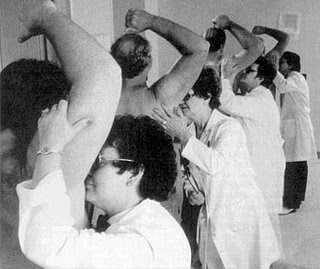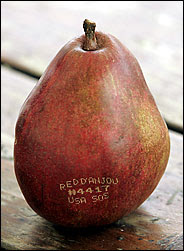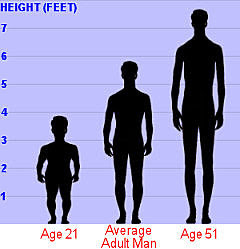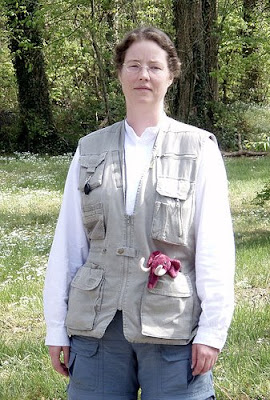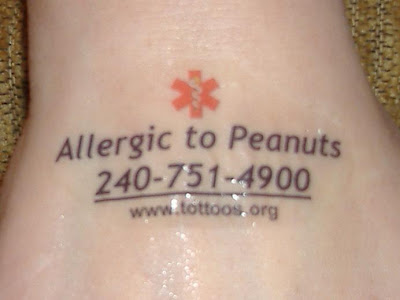
The other day I was dropping my son off at daycare. This is a place I have visited twice a day, every day, for the last two years. The care providers are, if not my friends, at least extremely good acquaintances, and I chat and joke with them as I get my kid’s stuff on, or off, depending on which direction we’re headed.
One of the dropping off assignments at daycare is the filling out of a My Day Sheet. The My Day Sheet is a piece of paper that tells the teacher what’s up with your kid: the last time he ate; when his last diaper change occurred; what you brought him for lunch and so on. There’s also a little Notes section where you can write things like “Oliver’s been complaining of an earache,” or “Oliver’s been displaying some interest in using the potty. Please encourage.”
On the morning in question, partly because I’d ordered the large coffee at Java Detour, and partly because I’m just an irascible scamp, I used the Notes space to write the words “Do not beat!”
Now, as I’m an inveterate and long-time scribbler of funny and semi-funny things in blank spaces on forms, I didn’t really think much of this little gag. I guess I hoped at most the teacher who read it would have a chuckle.
Turns out, in the world of modern childcare, there are no jokes.
By the time I made the 10-minute drive home, I had two missed calls on my cell phone and the phone in the office was ringing. I picked it up and quickly found myself in conversation with the director of the facility who was demanding to know who was beating Oliver, where I got my information and what we were to do about it.
Seriously, childcare people?
You seriously think that if I found out you were beating my son, the way I’d choose to communicate my concerns would be via a note on the My Day Sheet? And furthermore, you seriously think I’d then re-entrust my abused offspring into your care with a mild written rejoinder and perhaps the threat that if you continued to beat him I’d have to break out the Post It notes?!?!
The current child-rearing climate in this country is one of borderline panic: peanuts are feared and loathed, disinfectants have replaced juice as the drink of choice and blocks are banned from schools because they set up a competitive environment for the kids.
Do we really want to raise our kids in this fog of war? These trends are easy to poke fun at, but the fact is, scaring the crap out of our kids exposes them to a lot more dangers than it protects them from.
We all know obesity and diabetes numbers are soaring because kids don’t play outside anymore. Do you think this might be because between the smog warnings and abducted child Amber alerts being beamed to our cell phones our kids are afraid to leave the house? Do you think maybe by the time they strap on the elbow pads and wrist guards, apply sunscreen, hide a GPS device in their sock, disinfect their hands and fill out an insurance waiver, the prospect of going to the only semi-fun, but extremely safe rubber jungle gym just isn’t that appealing anymore?
We may have protected our kids from skinned knees, but have we given them heart disease and hypertension in the process?
Every morning, when I’m packing Oliver’s lunch, I have to write out exactly what’s in the container in case someone in his class is allergic to something. Now, being me, I can’t resist having some fun with this. I’ll tape a label that says “apple,” for example, on an apple, or I’ll write things up as if they were menu items at a four-star restaurant—“tender macaroni elbows in a silky, decadent reduction of milk and cheese…”
But this is a laugh-to-keep-from-crying strategy. The reality is that the threat of food allergies in this country has been exaggerated to such a degree that it’s probably hurting more kids than it’s helping.
The Food Allergy and Anaphylaxis Network, a relentless non-profit organization bent on promoting awareness of food allergies, has been so effective in its mission that six states have passed laws requiring schools to stock anti-anaphylaxis measures and congress is considering further legislation. The only problem is, FAAN may be taking advantage of panicked parents and a fear-mongering media to spread the word of some pretty shoddy science.
The FAAN’s comments on the FDA’s 2005 Food Safety Survey hold that anaphylaxis is “a severe, potentially life-threatening allergic reaction which results in 30,000 Emergency Department visits and 150-200 deaths each year in the US.” However, the FAAN built the website it used to publicize these numbers using a donation from the chemical company Dey—manufacturer of the EpiPen, an adrenaline injector which combats anaphylactic shock. The Center for Disease Control and Prevention, which is funded by the government, sets the number of annual food allergy deaths from causes anaphylactic or otherwise at around 12.
Sadly, there’s no longer anything shocking about a company creating—or at least running a publicity campaign for—a malady it plans to profit by curing. But unlike the makers of Listerine simultaneously creating and curing halitosis, the effects of selling the public on an explosion of food allergies are far from benign.
Studies have shown children thought to have food allergies are more anxious and fearful than even those with diabetes and rheumatological diseases. And psychosomatic allergic reactions are on the rise as well. This raises the somewhat chilling question, “Are we actually giving our kids allergies?”
In 1999 a manufacturing glitch caused a slight change in the way a Belgian Coca Cola plant blended its product. Coca Cola is the world’s most recognizable commercial taste, and when the plant used what is now believed to have been substandard (but harmless) carbon dioxide in the soft drink, consumers detected the difference.
During the same summer, much was being reported in the European media about both mad cow disease and a dioxin scare in Belgium. So when people tasted the tainted Coke, many thought they’d been poisoned. The first case was a group of 42 school children in Bornem who were hospitalized with nausea and cramping. Following this, the “contamination” spread, psychosomatically, until hundreds of people in Belgium and France had been hospitalized, actually sick, from drinking slightly differently flavored Coke.
A similar episode from my own life confirms that all-too-real symptoms can derive from entirely benign causes. I once lived for three years in the country of Latvia where local superstition held that were you to open two windows on opposite sides of a room, the resulting tsaurveish, or, crosswind, would give you a stiff neck.
You’d be sitting in a sweltering railroad car in the middle of summer and all but one window in the train would be shut. I once tried to crack a window to get a little air and about five people immediately barked at me to close it. I used to argue with people about the tsaurveish—asking them what differentiated an indoor crosswind from, say, just going outside, but they wouldn’t hear of it. Damned if those stubborn Latvians didn’t insist on getting real and painful stiff necks from excessive breeziness!
Your mind can make you sick. And it can also make your kid sick. Maybe if you tell your kid he’ll go into shock from breathing near a peanut, he’ll oblige you and do so. Or maybe he’ll just live in fear, skipping birthday parties and cloistering himself away from the other children at lunchtime. Maybe his self-enforced fragility will extend to other things. Maybe he’ll be too afraid to try karate, or dancing, or the violin.
We complain that our kids don’t get enough exercise. But can we really blame them when all we ever do is tell them how dangerous it is out there?
Oliver’s grandmother came to visit a couple months ago and we decided to go play on a nearby jungle gym. Unfortunately, when we got there, all we found was a static heap of rubberized blocks and platforms. Nothing swung, nothing spun, nothing dangled. It was safe, sure, but it was also impossible to play with. After about a minute and half, Oliver found himself more interested in a nearby trashcan than with the playground equipment. I don’t think I’ve ever seen a kid play on that apparatus.
We shoehorn four-year-olds into suits of armor before letting them roller blade down the block at three miles an hour. The message? This is an incredibly dangerous activity.
We make kids who can barely hold a bat wear chest protectors to play tee ball. Why? Because we read this one kid got hit in the chest with a ball once and his heart stopped.
Yeah, you know where we read that? On the box the heart-stopping chest protector thing came in. You know who told us elbow pads could save a half million lives a year? From the elbow pad salesman. You know where we heard anaphylaxis kills 200 kids a year? From the people manufacturing an anaphylaxis drug!
Yes, there are risks in the world. But there’s also a lot of money being spent to get us focused on the wrong ones. Maybe a kid’s heart stopped once when he got hit with a baseball; 700,000 hearts stop every year because of heart disease.
You want your kids to be happy and healthy? Maybe they need to get banged up once in while. That way, they’ll learn it’s not that bad. What they definitely don’t need is you serving as their personal terrorist. So, when you get home tonight, do your kid a favor: give him a PB and J and then knock him off his bike. We’ve all got a lot of unlearning to do.
PS: For more stats and a fitful over reaction to this story, check out #35 -
Humorlessness.
